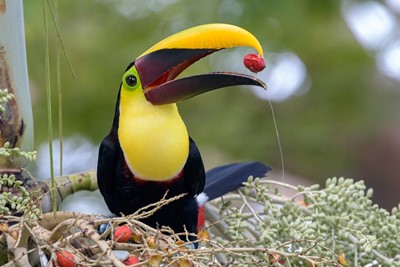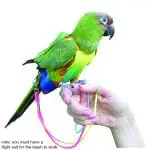The world of birds is so wide that it is full of different species that all have their own unique appearances and traits. Although you classify these feathered animals as “birds,” they all differ in terms of their physical attributes, habits, and overall demeanor. Simply put, there are all kinds of different birds that come in their own unique shapes, colors, sizes, and personalities.
If you are looking for one of the more unique types of birds in the world, Swainson’s Toucan is one of them. These are some of the more colorful and unique types of birds, even when compared to other toucans. That is why they are known to be very popular among bird owners. So, if the Swainson’s Toucan interests you, you might want to get to know more about this sleep-hungry bird.
What is the Swainson’s Toucan?
Overview
The Swainson’s Toucan is also called the Chestnut-Mandibled Toucan because of its overall appearance. This bird is actually a subspecies of the popular Yellow-Throated Toucan and is quite common in certain regions in South America. While they come from places such as Colombia, Ecuador, and Honduras, they have become some of the more popular pet birds in America ever since they were introduced into the pet trade market. They are actually the most available large toucans in the United States.
Although this bird is better known as the Chestnut-Mandibled Toucan, its popular English name “Swainson’s Toucan” is commemorative of William Swainson, the English Ornithologist responsible for classifying this unique type of toucan. It was only in 2009 when the Swainson’s Toucan was recognized as a subspecies of the Yellow-Throated Toucan. Before that, it was considered to be its own unique species. They are long-lived species of birds that can live for up to 25 years when taken care of properly.
Physical Description
The Swainson’s Toucan carries the same similar physical appearance that is descriptive of other types of toucans in the sense that it has a very large bill that can be as long as more than half of the bird’s entire body. It is believed that the reason why the Swainson’s Toucan has a large beak is to allow it to reach fruits on branches that are too small to handle its entire body weight.
Speaking of the bird’s length, it is considered to be a pretty large bird compared to other species of birds. Males can be as large as 22 inches while females can grow up to 20.5 inches. Aside from size, there is no other way to tell apart the males from the females because they are actually so similar in terms of their overall appearance.
When it comes to this bird’s appearance, the Swainson’s Toucan has a body that is mainly covered by black feathers but may have maroon feathers near its head, lower breast, or even its upper back. Meanwhile, the bird’s face is almost always yellowish, which extends all the way to its upper breast. Its upper beak also carries the same yellow color that is prominent on its head, but the lower portion of the beak is maroon. Finally, the Swainson’s Toucan has eyes that are encircled with a light touch of green that blends well with its head’s yellowish color.
Natural habitat
The Swainson’s Toucan is naturally found in many Latin American regions but is more common in Honduras, Nicaragua, Costa Rica, and Colombia, among others. These are non-migratory birds that tend to stay in the same place for almost an entire lifetime. They are mostly found in tropical lowland rainforests and even in parks and gardens so long as there are trees that allow them to nest. That is why they are fairly common in Latin America as they can basically live anywhere so long as there are enough trees in the area. In America, they were introduced as pets and are more common in households than they are in the wild.
Captive habitat
You do not need to place the Swainson’s Toucan in a special cage. Any birdcage will do just fine as long as you keep in mind that this large bird needs to be housed in a cage that is at least three times its size so that it will have enough room to move around inside. There should also be a perch that is big and strong enough to handle the Swainson’s Toucan’s size.
Diet

The Swainson’s Toucans are omnivorous birds that can eat plant-based and meat-based food. However, it has been observed that this bird prefers to feed on fruits rather than on meat. That is why captive-bred Swainson’s Toucans are usually fed with different types of fruits instead of pellets and seeds. In fact, the reason why they have large beaks is to allow them to eat large pieces and quantities of fruits in a more efficient manner. They can eat over 100 different types of fruits.
Swainson’s Toucans are also capable of eating meat, but they only do so during nesting periods because they need protein during that time. If you want to give them protein, insects and smaller lizards are viable options for them. Try not to give them mice because they are low in protein and high in fat.
Personality and behavior
Swainson’s Toucans are known to be very smart and inquisitive birds that are curious enough to try to study their surroundings and environment. They are also quite friendly and playful birds to the point that they are willing enough to play with their owners. In the wild, they do not prefer to be in large flocks, particularly because of how the food will be much more difficult to come by when they join up together in a big group. Instead, the Swainson’s Toucan prefers to be alone or in a smaller group.
Swainson’s Toucan needs a lot of sleep
Aside from all of the basic information you need to know about the Swainson’s Toucan, one other thing that you should keep in mind about this bird is that this bird is a lot similar to any kind of animal in the sense that it needs a lot of sleep. However, Swainson’s Toucan is like most toucans when you consider the fact that it really needs more rest than most other types of birds.
Swainson’s Toucans, when they lack sleep, tend to be very cranky, aggressive, grumpy, and may even show the kind of behavior that you would not want your bird to have. On top of that, like any other species of birds, the Swainson’s Toucan may end up showing feather stress bars, which are indicative of how unhealthy the bird is and how it may be under a lot of stress. Feather stress bars can be dangerous because feathers easily break on the places where the stress bars are located and can lead to accidents on the part of your toucan.
All those considered, the Swainson’s Toucan should be given about 12 hours of uninterrupted sleep on a daily basis if you want it to end up healthy and stress-free. These birds should be placed in an environment that allows them to rest from the moment the sun goes down, and at the very moment when it rises once again. That is at least 12 hours. Make sure that they are housed in a cage that allows them to sleep well while placing them in a room that is quiet and with the right kind of temperature for these tropical birds.


